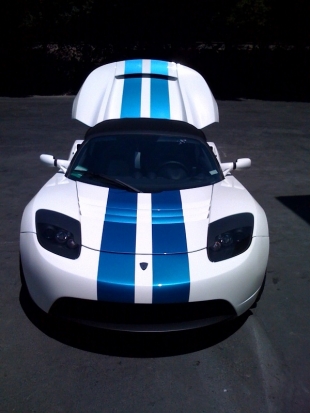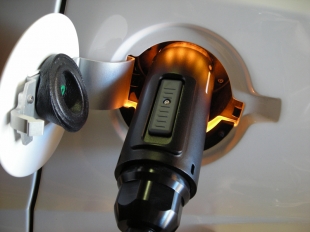 Fourteen years ago, I married my husband because he was kind, smart, trustworthy, had beautiful eyes – and he made me laugh. I didn’t marry him because he was any great environmentalist. Quite the opposite – he was (and still is) an engineer in the petroleum industry. In fact, we used to joke that my job is to clean up the pollution he helps create. So when he came up with the idea of buying the all-electric Tesla roadster, I was pleasantly thrilled – but I had nothing to do with it!
Fourteen years ago, I married my husband because he was kind, smart, trustworthy, had beautiful eyes – and he made me laugh. I didn’t marry him because he was any great environmentalist. Quite the opposite – he was (and still is) an engineer in the petroleum industry. In fact, we used to joke that my job is to clean up the pollution he helps create. So when he came up with the idea of buying the all-electric Tesla roadster, I was pleasantly thrilled – but I had nothing to do with it!
After, oh, a good two years of waiting, it’s finally Tesla time. The car arrived two weeks ago and it is quite remarkable. The paint job is the first striking thing (for racing enthusiasts, the blue-and-white color combination was a traditional American color scheme – alongside Ferrari red for Italy, and British racing green). Next is what’s behind the “fuel door”: a glowing light surrounding a receptacle for the charging cord. The light flashes more or less slowly depending on the rate of charge. For now we can charge from a regular 110-volt outlet; at that rate it takes 10 hours to charge the car 40 miles. Since my husband’s one-way commute is only 3 miles (I know, in LA, isn’t that just sick?), this slow charge presents no problem. (A faster charger is available.) Another remarkable thing is the range of the car – theoretically, it’s over 200 miles, though that’s only under certain ideal conditions, including no heat or A/C, or driving much over 55 mph. Still, the car’s practical range is proving to be about 140 miles, and that’s not bad.
Then there’s the ride. Last year during our test drive, we were confined to the congested surface streets of Brentwood, but now we can zip along any freeway, and zip we do. This car can go from here to there almost as fast as you can think it – it’s a little like teleporting. Whether you’re going zero or sixty, you’ve got all the pickup you could possibly want, or use (at least in my view). But for me the best part of all is the fact that nothing is coming out of a tailpipe. I’ve said it before, and I’ll say it again: it is wonderful to drive without polluting (on the spot).
 Of course the energy is coming from somewhere, and that was one of the topics of conversation at the Plug-In 2009 conference this week in Long Beach. Tuesday was “public night,” and following a whirlwind tour of the exhibit hall, we joined about 300 of our closest friends for a Q&A panel discussion with Chris Paine, who directed the movie “Who Killed the Electric Car?,” Chelsea Sexton, a former General Motors EV-1 specialist who appeared in the film, and Bill Nye, “The Science Guy.” All the panelists were excited about plug-in hybrid and electric cars, and were optimistic that their adoption is on an upward swing. Questioners who asked about the sufficiency of electric power if “everyone” switched to electric cars were reassured that this won’t be an obstacle. Using electrical energy to move an electric car, Bill Nye observed, is about three times more efficient, considering the whole energy loop, than the way we do it now using petroleum.
Of course the energy is coming from somewhere, and that was one of the topics of conversation at the Plug-In 2009 conference this week in Long Beach. Tuesday was “public night,” and following a whirlwind tour of the exhibit hall, we joined about 300 of our closest friends for a Q&A panel discussion with Chris Paine, who directed the movie “Who Killed the Electric Car?,” Chelsea Sexton, a former General Motors EV-1 specialist who appeared in the film, and Bill Nye, “The Science Guy.” All the panelists were excited about plug-in hybrid and electric cars, and were optimistic that their adoption is on an upward swing. Questioners who asked about the sufficiency of electric power if “everyone” switched to electric cars were reassured that this won’t be an obstacle. Using electrical energy to move an electric car, Bill Nye observed, is about three times more efficient, considering the whole energy loop, than the way we do it now using petroleum.
I can’t imagine that power companies, whether municipal or private, won’t be happy to find ways to supply us with enough juice for our cars. My friend who works for So Cal Edison confirmed that there is plenty of off-peak power to charge vehicles. Some upgrading of local transformers will be needed to handle the power draw of several vehicles charging on one block. While we’re still a long way from this scenario, it’s worth noting that it’s far easier to control emissions from a central power plant than from millions of tailpipes. Even more intriguing is the idea that our electric vehicles can serve as a vast energy reservoir, storing power in their batteries and able to send it back into the grid when we don’t need it. Bill Nye advised that whoever comes up with that next battery-technology breakthrough is going to get “Bill-Gates rich.” So kids, hit those science textbooks!
We concluded our evening in electric-car world by comparing notes with friends who had retrofitted a Geo Metro. A raft of batteries were stored in the rear of the car, connected with two different types of charging outlets for flexibility. Still plenty of cargo space left over, by the way. A repurposed solar panel adorned the hood to help keep the 12-volt battery charged for support systems. Being both ambitious and handy, this couple had done the conversion themselves, but commercial conversions are available. I know most people are not in a position to run out and buy a Tesla, but there are many paths to low- or no-emission cars, and it’s great to know that whatever their motivation, more and more Americans are starting to check them out.

